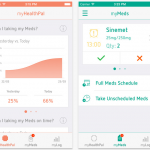 18 months or so ago, I wrote about the way Ginger.io was using data to improve our health. The app mines the data generated by your smartphone usage to determine lifestyle trends that it can then utilise to provide you with health insights and alerts.
18 months or so ago, I wrote about the way Ginger.io was using data to improve our health. The app mines the data generated by your smartphone usage to determine lifestyle trends that it can then utilise to provide you with health insights and alerts.
“It forms an automated diary of your life,” said Anmol Madan, co-founder and CEO of Ginger.io. “The idea is to provide support to patients and families.”
The data generated by an individuals normal phone usage forms part of the general data collection undertaken by the app. They then harvest more specific data courtesy of condition-specific surveys about their symptoms and general well-being.
Of course, they are one of many organizations attempting to take the plethora of data generated about our health and wellbeing to improve our lives. One such project is called MyHealthPal, and they want to provide users with a platform to donate the data they generate about their health to various charities and institutions that are working to improve our understanding of health issues.
The data is generated by interacting with the platform, which provides patients with Parkinson’s with a range of analytics functions. The free service allows users to input details about their daily behavior, moods and symptoms, before then transforming this data into some nice looking visuals to help the patient better understand their condition.
The platform then allows users to share these visual displays with friends and families, and of course their doctors too, whilst also making the data available to medical researchers should they wish.
The app makes this sharing easy to manage, with various games built into the system to help monitor each patients condition.
The service was developed by Parkinson sufferer Mike Barlow, who felt there was a distinct need for just such a service. It is currently based purely upon Parkinson’s, but it could possibly expand into other long-term conditions in the coming years.
It’s an interesting sign of things to come for the management of long-term conditions, and how the data generated about the condition by patients can help further research into the condition.